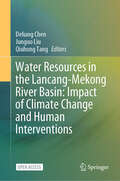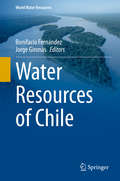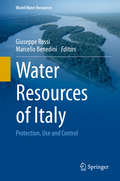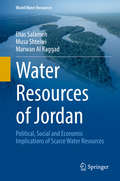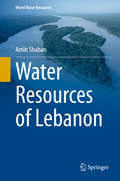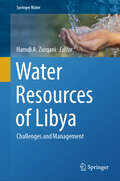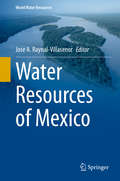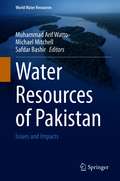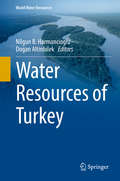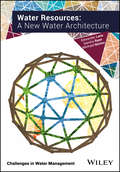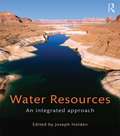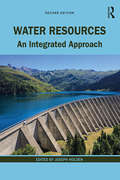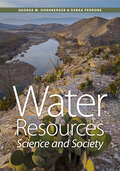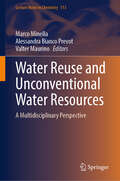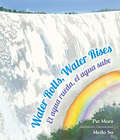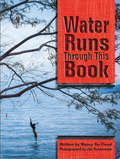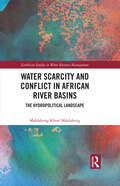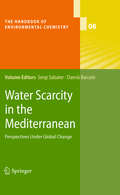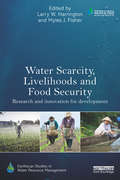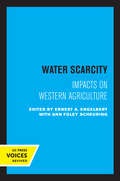- Table View
- List View
Water Resources in the Lancang-Mekong River Basin: Impact of Climate Change and Human Interventions
by Qiuhong Tang Deliang Chen Junguo LiuThis open access book provides a comprehensive, up-to-date picture of the current state of knowledge covering climate change, surface water change, arsenic pollution, water utilization, water-food-energy nexus, water related hazards, water management, and water governance in the Lancang-Mekong River Basin. Considering the widely concerned fact that the climate change and human intervention induced impacts on water will bring unprecedented threats to human societies and ecosystems, the book intends to support UN’s sustainable development goals through sustainable use of water by providing the most accurate and updated information on climate and water changes in a consistent way. Underlying all aspects of the book is a strong commitment to assessing the science comprehensively, without bias and in a way that is relevant to policy but not policy prescriptive. It can provide implications to support decision-makers and stakeholders for integrated water resources management and sustainable development at all levels.
Water Resources of Chile (World Water Resources #8)
by Bonifacio Fernández Jorge GironásChile is a privileged country in terms of water resources, with an average annual runoff of approximately 50,000 m3/person. However, water availability varies enormously in space, as less than 1,000 m3/person are available for more than 50% of the population. The temporal and spatial distribution of water resources is driven by processes highly variables across a country with different climates explained not only by a large range of latitudes (from 17° to 56° south), but also the presence of the Pacific Ocean and the Andes with peaks up to 7000 m. This geography makes of Chile a true natural laboratory in which water is essential for the society and the economy of the country. The relevance of water resources for the country has become even more significant in the context of a mega-drought that has affected practically the entire territory in recent years, although large floods such as those in Atacama 2015 and 2017 also take place periodically. This unique book brings together the state-of-art knowledge about the hydrology of Chile and its water resources, with a particular focus on quantitative aspects. The chapters are prepared by many of the most relevant researchers and practitioners working in water resources in the country. High-quality research contributions on climate and meteorology, surface and subsurface hydrology, water quality, water monitoring, water resource and global change, among other issues, are presented in this unique book, which offers a useful guide for academicians, researchers, practitioners and managers dealing with diverse water-related issues in Chile and other regions with similar characteristics
Water Resources of Italy: Protection, Use and Control (World Water Resources #5)
by Marcello Benedini Giuseppe RossiThis book offers a comprehensive framework of the current state of water resources in Italy and of the main stages of the evolutionary way in the last decades for achieving an integrated, sustainable and equitable water resources management. The main paradigms of water resources development are identified as: i) engineering and economic approach to water resources exploitation, ii) focus on pollution control and water-excess management, iii) a comprehensive approach toward a sustainable and equitable distribution of resources and effective risk reduction of water-related disasters. After a section devoted to the analysis of some historic stages in the legislation framework and the governance of water and soil, with particular reference to planning, design, building and operation of water systems, two sections deal with the estimation of water resources availability on national territory and estimation of water demands in municipal, agricultural, industrial, ecosystem sectors. The complex problems that the Italian society has to solve in the water field and the main challenges of a changing world are discussed in the fourth section of the volume. The book will not only be useful for water professionals, but also for citizen who like to discern the key factors which delay the recognition of water as a resource for life. The description of the problems and adopted solutions could also serve as a guideline for similar situations encountered in other countries, improving the preparation of the responsible people.
Water Resources of Jordan: Political, Social And Economic Implications Of Scarce Water Resources (World Water Resources #1)
by Elias Salameh Musa Shteiwi Marwan Al RaggadThis book gives a detailed account of the scarce water resources of Jordan, with a focus on their quantities, quality, and use for different sectors. It details the political, social, and economic dimensions of the scarce water resources along with their implications on Jordan's cooperation with its neighbors. The book includes implemented projects of dams, canals, water supply networks, waste water treatment, and more. It gives an overview of which projects have been successful and which have failed to achieve their purposes and why. Shared water with other countries and their developmental implications to the water sector are discussed and future water supply projects, such as the Red Sea-Dead Sea conduit project, are elaborated on. The book also touches upon the waves of refugees and their impact on the water sector and water strategies in Jordan.
Water Resources of Lebanon (World Water Resources #7)
by Amin ShabanWater has become a challenging resource that many countries worldwide are concerned with. Thus, water is often linked with health, society development, national income and even international geo-politics. Sometimes, water resources are unavailable, but successful management involves developing approaches and projects to assure water supply. However, there are some countries with available water resources, but unsatisfactory management, and thus complain about water supply becoming a national problem. This situation is prevalent in Lebanon, a country characterized by abundant water resources whether on the surface or sub-surface. It is a paradox that there is still imbalance in water supply/demand in Lebanon, and water resources are now under stress due to chaotic use. This has been exacerbated by the oscillating climatic conditions, increased population and improper management. Therefore, people receive less than one-third of their water needs, and most water supplied is of poor quality. The current status shows a descending trend. Undoubtedly, if the water sector in Lebanon continues this way, we should anticipate unfavourable (and may be severe) consequences. Many studies have been conducted on water and related disciplines in Lebanon; however, all of them focus on specific themes and sometimes defined regions. Nevertheless, the occurred changes on the influencers (natural and man-made) have not been considered. This book is the first of its type for Lebanon, and it shows all aspects of water resources with updated measurements and findings obtained by adopting new techniques. It diagnoses in-depth the major elements of water flow/storage mechanism that have never been covered in such a comprehensive manner before. Also, this book introduces and analyses the existing challenges and proposes solutions. It represents a comprehensive investigation of the water resources in Lebanon.
Water Resources of Libya: Challenges and Management (Springer Water)
by Hamdi A. ZurqaniThis book addresses a range of water resources management issues, especially those that are relevant to the water quality in Libya. It covers topics such as the assessment and prediction of water quality, salt-water intrusion, treatment of wastewater for reuse, and desalination as an alternative source of water. It provides up-to-date information on the impact of climate change on water resources in Libya and summarize the latest results of several systematic investigations and assesses the occurrence and quality of surface and underground waters in the country to help decision-makers plan for sustainable development. The methods presented in this book can also be applied in other regions with similar climate conditions. This book will share the knowledge and experience of experts and scientists who apply high-quality findings and input from their research to issues concerning the management of water resources and their quality in Libya.
Water Resources of Mexico (World Water Resources #6)
by Jose A. Raynal-VillasenorThis comprehensive volume presents the topic of water resources of Mexico from a different angle. Besides covering the geohydrology it also offers a brief account of the ancient water resources works, explains from where the water is coming, how the water is being used in homes and in the industry, how the dams are operated in the hurricane season, some aspects of the water-energy-food securities nexus and the expectations for the future in connection with global climate change. The book is of interest to every one connected with the water resources of Mexico, e.g. federal and state employees of agencies related with water management, water supply and wastewater treatment. It is also of value to those in academia and employed at water related professional associations and the general public.
Water Resources of Pakistan: Issues and Impacts (World Water Resources #9)
by Michael Mitchell Muhammad Arif Watto Safdar BashirThis book presents the first comprehensive assessment of water resources in Pakistan including surface water resources and groundwater resources. It gives a detailed overview of issues and challenges related to water which have not been adequately addressed e.g. water resource vulnerability to climate change, groundwater depletion and contamination, and water governance etc. It includes a collection and compilation of unpublished and scattered data from the archives and repositories of various national institutions and organization.Given the literature dearth, this book will not only be a comprehensive assessment of water resources in Pakistan but can also can as outstanding textbook on water resource management in Pakistan. It will attract a great range of readership including water specialists, researchers, undergraduate and post graduate students and policy makers from Pakistan as well as from overseas.
Water Resources of Turkey (World Water Resources #2)
by Dogan Altinbilek Nilgun B. HarmanciogluThis book provides an in-depth description of water resources of Turkey, a country with a unique geographical location, extending from the Mediterranean in Europe to the Middle East. Its varying geography, topography, hydrology, geology and climate are reflected in the diverse characteristics of its water basins. Furthermore, due to its geographical location, Turkey has a significant number of transboundary river basins and has to share its water resources with its neighbors, an issue that can sometimes lead to water conflicts.Turkey is also an interesting example of a developing country that is attempting to adapt to universal water management strategies while at the same time facing legal, institutional, economic and capacity development problems. It has long remained a water-rich country, but the situation is now changing due to the increasing population, inefficient use of resources, and the impacts of climate change and environmental degradation.This book is useful for national and international organizations as well as water resources professionals. It takes on an added significance in the light of climate change in the region, water management problems and transboundary water basins.
Water Resources: A New Water Architecture (Challenges in Water Management Series)
by Michael Norton Sandra Ryan Alexander LaneOver 7 billion people demand water from resources that the changing climate is making more and more difficult to harness. Water scarcity and shortage are increasingly common and conditions are becoming more extreme. Inadequate and inappropriate management of water is already taking its toll on the environment and on the quality of life of millions of people. Modern water professionals have a duty to develop sound water science and robust evidence to lobby and influence national and regional development policy and investment priorities. We need to be bold and brave to challenge the status quo, argue the case for change, and create a New Water Architecture. Water Resources: A New Water Architecture takes a unique approach to the challenges of water management. The stress caused by our desire to live, eat, and consume is examined in the context of Governance, the role of policy, and the commercial world. The authors share their nine-step vision for a New Water Architecture. Written by three industry practitioners, this book provides students, young professionals, policymakers, and those interested in the sustainability of our natural resources with a pragmatic and compelling perspective on how to manage the ultimate resource of our time.
Water Resources: An Integrated Approach
by Joseph HoldenThe world faces huge challenges for water as population continues to grow, as emerging economies develop and as climate change alters the global and local water cycle. There are major questions to be answered about how we supply water in a sustainable and safe manner to fulfil our needs, while at the same time protecting vulnerable ecosystems from disaster. Water Resources: An Integrated Approach provides students with a comprehensive overview of both natural and socio-economic processes associated with water. The book contains chapters written by 20 specialist contributors, providing expert depth of coverage to topics. The text guides the reader through the topic of water starting with its unique properties and moving through environmental processes and human impacts upon them including the changing water cycle, water movement in river basins, water quality, groundwater and aquatic ecosystems. The book then covers management strategies for water resources, water treatment and re-use, and the role of water in human health before covering water economics and water conflict. The text concludes with a chapter that examines new concepts such as virtual water that help us understand current and future water resource use and availability across interconnected local and global scales. This book provides a novel interdisciplinary approach to water in a changing world, from an environmental change perspective and inter-related social, political and economic dimensions. It includes global examples from both the developing and developed world. Each chapter is supplemented with boxed case studies, end of chapter questions, and further reading, as well as a glossary of terms. The text is richly illustrated throughout with over 150 full colour diagrams and photos.
Water Resources: An Integrated Approach
by Joseph HoldenNow in its second edition, Water Resources: An Integrated Approach provides students with a comprehensive overview of natural processes associated with water and the modifications of these processes by humans through climate change and land management, water-related health issues, engineering approaches to water and socio-economic processes of huge importance to water resources. The book contains chapters written by 24 specialist contributors, providing expert depth of coverage to topics. The text introduces the basic properties of water and its importance to society and the nature of the different regional imbalances between water resource availability and demand. It guides the reader through the changing water cycle impacted by climate and land management, water flows in river basins, surface water quality, groundwater and aquatic ecosystems, and covers the role of water in human health and associated hazards before turning to engineering solutions to water and wastewater treatment and reuse. The book deals with physical and social management strategies required for water resource planning, the economics of water and treatment of issues associated with conflict over water. The concept of virtual water is covered before the text concludes with a chapter considering the challenges of predicting future water issues in a rapidly changing world and where environmental systems can behave in a non-linear way. The need to work across disciplines to address challenges that are connected at both local and global scales is highlighted. Water Resources also includes global examples from both the developing and developed world. There are 58 case study boxes. Each chapter is supplemented with these case studies and with reflective questions, project ideas and further reading, as well as links to a glossary of terms. The book is richly illustrated throughout with over 160 full-colour diagrams and photographs. The text provides a novel interdisciplinary approach to water in a changing world, from an environmental change perspective and interrelated social, political and economic dimensions. It will be an indispensable guide to undergraduates studying Water Resources and Management, Geography of Water, and Water in the Environment.
Water Resources: Science and Society
by George M. Hornberger Debra PerroneA scientifically rigorous text grounded in socioeconomic reality that examines both physical hydrology and contemporary water usage issues.The fair allocation and wise use of fresh water presents significant challenges across the world. To avoid unresolvable crises in the future, judiciously managing water resources in the twenty-first century is fundamentally important. Integrating the underlying science of hydrology with real-world usage scenarios, Water Resources offers a nuanced, modern treatment of contemporary water resource management issues.In this ground-breaking new text, renowned environmental scientist and educator George M. Hornberger and award-winning environmental engineer Debra Perrone examine the role of water resources in natural, social, and human-built systems, helping students understand and evaluate the complex tradeoffs required to achieve sustainable water management. Providing a much-needed educational tool that looks at freshwater resources within the context of the crucial water-energy-food nexus, the text • includes a primer on the elements of physical hydrology necessary to understand resource availability; • covers rivers, lakes, groundwater, and soil water;• relates water to agriculture, energy, urbanization, and the environment;• highlights connections between water quantity and quality; • explains the economic and legal constraints around water resources; • considers the impacts of climate change and population growth; and• proposes paths forward for the sustainable use of water.Teaching basic methods used to make informed water management decisions, the book includes illustrative quantitative calculations, qualitative think-pieces, and case studies. An appendix provides a review of units, dimensions, and conversions useful for addressing each chapter's example problems. Online answer keys are also available.Positioned to become the foremost text on water resource issues, this companion to Hornberger's widely regarded Elements of Physical Hydrology reveals the enormity of the water crisis facing the planet while offering realistic hope.
Water Reuse and Unconventional Water Resources: A Multidisciplinary Perspective (Lecture Notes in Chemistry #113)
by Alessandra Bianco Prevot Marco Minella Valter MaurinoThis book covers the latest technologies and challenges for water reuse and unconventional water resources. It presents a comprehensive overview of water reuse as a key approach toward a sustainable solution, and it offers an important multidisciplinary perspective. The book brings together topics spanning from water treatment technologies to social expectation and acceptance, from integrated decisional platforms for policymakers to industrial symbiosis, and from environmental sustainability to legislation aspects. It appeals to both academic and non-academic lecturers, being a valuable resource for teaching and research. Divided into 4 parts, the book begins with an introduction to water quality and quantity evaluation and the opportunities and challenges of conventional and unconventional water sources. In the second part of the book, readers will learn about the established and innovative strategies for water reuse, including the recent advances in water and the analytical challenges. In Part 3, expert contributors examine policies, plans and regulations for water reuse, with a focus on the European Union Regulation 2020/741. The final part of this book offers a perspective on wastewater reuse in practice, including several case studies of successful water reuse initiatives. Given its breadth, this book is a valuable resource for PhD students, post-doc researchers, and professionals from water utilities and diverse water user sectors such as agriculture and industry. The book caters to those seeking to deepen their knowledge and contribute to innovative solutions for sustainable water reuse. It also supports and advances the UN’s sustainable development goals, in particular SDG6 (Clean Water and Sanitation). Chapter 17 Water Reuse in the European Union: Risk Management Approach According to the Regulation (EU) 2020/741 in this book is available open access under a CC BY 4.0 license at link.springer.com.
Water Rights and Social Justice in the Mekong Region
by Kate Lazarus Bernadette P. Resurreccion Nga Dao Nathan BadenochThe Mekong Region has come to represent many of the important water governance challenges faced more broadly by the mainland Southeast Asian region. This book focuses on the complex nature of water rights and social justice in the Mekong region. The chapters delve into the diverse social, political and cultural dynamics that shape the various realities and scales of water governance in the region, in an effort to bring to the forefront some of the local nuances required in the formulation of a larger vision of justice in water governance. It is hoped that this contextualized analysis will deepen our understanding of the potential of, and constraints, on water rights in the region, particularly in relation to the need to realize social justice. The authors show how vitally important it is that water governance is democratized to allow a more equitable sharing of water resources and counteract the pressures of economic growth that may pose risks to social welfare and environmental sustainability.
Water Risk Modeling: Developing Risk-Return Management Techniques in Finance and Beyond
by Thomas Walker Dieter Gramlich Maya Michaeli Charlotte Esme FrankThis book sheds light on the topic of financial water risk by examining the modeling challenges associated with physical, regulatory, and reputational water risk in finance. It explores various approaches to operationalize water risk from a financial analysis, investment management, and climate science perspective. The analysis of tools to assess water risk provides the basis for the development of appropriate risk-return management techniques in finance and beyond. This book provides new insights by focusing on financial water threats and their related opportunities. It will be of interest to both academics and practitioners who work at the interface of finance, economics, nature, and society.
Water Risk and Its Impact on the Financial Markets and Society: New Developments in Risk Assessment and Management (Palgrave Studies in Sustainable Business In Association with Future Earth)
by Thomas Walker Dieter Gramlich Kalima Vico Adele Dumont-BergeronWater risks, including the lack of access to fresh water for personal and industrial use, droughts, floods, and water contamination, are problems that are not new, yet, they are amplifying in the face of climate change, population growth, and rapid economic development. Properly identifying, measuring, and managing these risks as well as taking advantage of related mitigation opportunities is essential for the future well-being of firms across various industries, investors who invest in these firms, local and federal governments, and ultimately our society as a whole. This edited book sheds light on this topic by examining the unique measurement and modelling challenges associated with either the scarcity or overabundance of water and their interaction with finance and society. Specifically, it explores approaches to assess and operationalize water risk, examines the vulnerability of institutions and markets, and discusses strategies for risk mitigation.
Water Rolls, Water Rises / El agua rueda, el agua sube: El Agua Rueda, El Agua Sube
by Pat MoraNow in paperback: In a series of poetic verses in both English and Spanish, readers learn about the movement and moods of water around the world and the ways in which water affects different landscapes and cultures.Water rolls/El agua rueda onto the shore/hacia la orilla under the sun, under the moon./bajo el sol, bajo la luna. Here is an ode to the beauty of the natural world as expressed by the movement and moods of water. With every evocative verse, we visit one of fourteen different water landscapes and cultural areas around the world. Each is stunningly illustrated with a breathtaking view of the drama, joy, power, serenity, grandeur, or peacefulness of water. From the Grand Canal of Venice to Qutang Gorge in China, from the Sahara in Morocco to the Andes of Chile, we learn about the world through the lens of water, our most precious, life-giving resource.
Water Runs Through This Book
by Nancy Bo FloodA beautiful combination of photographs, verse, and narration celebrating the most essential ingredient to life: water. Author and educator Nancy Bo Flood explores this ever-changing and mysterious element. Poems and stories celebrating water are paired with stunning photographs from Jan Sonnenmair. Water Runs Through This Book will inspire a passion for the wonders of nature.Nancy Bo Flood is an author, psychologist, teacher, and mother who writes about what she enjoys--children and foreign cultures. She has taught in several different cultures, including Japan, Saipan of Micronesia, Hawaii, and Samoa. She lives on the Navajo Reservation in northern Arizona.Jan Sonnenmair is an award-winning Portland, Oregon, based commercial and documentary photographer who focuses her work on women, children and social issues around the world. Jan helps NGOs, corporations, universities, and publications tell stories with imagery.
Water Safety, Security and Sustainability: Threat Detection and Mitigation (Advanced Sciences and Technologies for Security Applications)
by Ashok Vaseashta Carmen MafteiThis book focuses on threats, especially contaminants, to drinking water and the supply system, especially in municipalities but also in industrial and even residential settings. The safety, security, and suitability landscape can be described as dynamic and complex stemming from necessity and hence culpability due to the emerging threats and risks, vis-a-vis globalization resulting in new forms of contaminants being used due to new technologies. The book provides knowledge and guidance for engineers, scientists, designers, researchers, and students who are involved in water, sustainability, and study of security issues. This book starts out with basics of water usage, current statistics, and an overview ofwater resources. The book then introduces different scenarios of safety and security and areas that researchers need to focus. Following that, the book presents different types of contaminants – inadvertent, intentional, or incidental. The next section presents different methodologies of contamination sensing/detection and remediation strategies as per guidance and standards set globally. The book then concludes with selected chapters on water management, including critical infrastructure that is critical to maintaining safe water supplies to cities and municipalities. Each chapter includes descriptive information for professionals in their respective fields. The breadth of chapters offers insights into how science (physical, natural, and social) and technology can support new developments to manage the complexity resident within the evolving threat and risk landscape.
Water Scarcity and Conflict in African River Basins: The Hydropolitical Landscape (Earthscan Studies in Water Resource Management)
by Mahlakeng Khosi MahlakengThe book presents a critical and comparative analysis of the hydropolitical landscape of African transboundary river basins which, for much of the past century, have been affected by water scarcity. River and lake basins can become a source of tension and conflict due to a complicated mix of environmental, demographic, diplomatic, historical and geopolitical factors. This book, however, specifically focuses on the important, and often under looked, role played by scarcity in generating or exacerbating conflicts in shared river basins. Asserting that transboundary river basins tie states into a web of interdependence, this book raises awareness of how water scarcity, or the depletion of water resources, complicates this relationship as nations are forced to look beyond their own borders to meet the demand for water to satisfy multiple needs. Taking a comparative approach, it examines three shared basins: the Orange-Senqu, the Nile and the Niger River basins. While situated in different regions, all three basins are marked by serious environmental challenges that are detrimental to combustible hydropolitics over such shared water resources and they provide fascinating insights into the links between climate variability and change, water resources, human security, conflict, adaptation and regime capacity. Overall, this book argues that conflict over transboundary resources can be prevented given the establishment of norms, rules, and the role of external actors that help regulate state behaviour and control their impacts. This book will be of great interest to students and scholars of water resource management, hydropolitics, environmental conflict, resource scarcity and international relations. It will also be of interest to policymakers involved in transboundary water resource governance.
Water Scarcity in the Mediterranean
by Sergi Sabater Damià BarcelóWater scarcity affects hydrologic resources, systems connectivity, biodiversity, water quality, and river ecosystem functioning. It has direct impacts on economic sectors that use and depend on water, such as agriculture, tourism, industry, energy and transport. The Mediterranean Basin is one of the regions in the world most vulnerable to climate changes, as well as one of the most impacted by human water demand. This volume provides an in-depth view of the water quality and quantity implications of water scarcity. It highlights its possible causes and describes the effects in regions under Mediterranean climate. The topics covered include climate effects, water resources (use, storage and new sources), water quality (chemical and microbiological), and the effects on ecosystems suffering from water scarcity. This book is addressed to scientists and students, but also to managers involved in the necessary decision making process to face future periods of drought.
Water Scarcity, Livelihoods and Food Security: Research and Innovation for Development (Earthscan Studies in Water Resource Management)
by Larry W. Harrington Myles J. FisherThis volume reviews the evolution of ten years’ learning and discovery about water scarcity, livelihoods, and food security within the CGIAR Challenge Program on Water and Food. It draws on the experiences of over 100 projects conducted in ten river basins in the developing world. The book describes how the program’s design evolved from an emphasis on water scarcity, water productivity, and water access to an emphasis on using water innovations to improve livelihoods and address development challenges in specific river basins. It shows how the research was used to foster change in stakeholder behavior, linking it to improved knowledge, attitudes, and skills, which were fostered by stakeholder participation, innovation, dialogue, and negotiation. The authors describe development challenges, their drivers and their political context, how to address them through technical, institutional, and policy innovations; and the consequences of change at different scales, time frames on equity, resilience, and ecosystem services. Overall, the work represents a major synthesis and landmark publication for all concerned with water resource management and sustainable development.
Water Scarcity: Impacts on Western Agriculture
by Ernest A. Engelbert Ann Foley ScheuringAgricultural production in the semi-arid western United States is dependent on irrigation. Population in the seventeen western states has been and is expected to continue increasing. Groundwater levels are declining throughout the region with long-term pumping and increased demands leading to greater pumping lifts and costs, land subsidence, and salt water intrusion into groundwater basins. Construction and operation costs of future water development in these states will be great, both in dollars and in economic and social effects. Competition for the available water supply due to increased demands in both agricultural and non-agricultural sectors continues to increase. Although considerable attention has been given to some aspects of declining water supplies for irrigated agriculture in particular areas, this is the first volume to adress in a comprehensive manner the effects of scarce water supplies on agricultural production and the resultant impacts at regional, state, national, and international levels. Over seventy experts, representing all the major physical and social sciences as well as industries examine the issues and conclude that important decisions must be made at all levels of government and private enterprise if the prosperity and quality of life in the region are to be maintained. Specific technical, economic, institutional, and managerial solutions are recommended to forestall an impending water crisis. All segments of society--agriculturalists, urbanites, food processors, land developers, environmentalists, and others--have major stakes in the outcome of any action for future water supplies and distribution in the West. This title is part of UC Press's Voices Revived program, which commemorates University of California Press's mission to seek out and cultivate the brightest minds and give them voice, reach, and impact. Drawing on a backlist dating to 1893, Voices Revived makes high-quality, peer-reviewed scholarship accessible once again using print-on-demand technology. This title was originally published in 1984.
Water Science and Sustainability (Sustainable Development Goals Series)
by Subhash Anand Bindhy Wasini PandeyThis book describes the importance of water resources for socio-economic and ecological development including geomorphic and ecological environments. Hence, conservation, management and development of water resources have become necessary for the all-around development of global populations and the environment. It is the outcome of valuable contributions made by eminent scientists and research scholars who have developed alternative strategies, solutions and models for sustainable water resources through research, monitoring and experiments varying from regional to global scale. This book is of immense use to the policymakers, environmentalists, ecologists, academician, research scholars and people in general concerned with water resources management.
